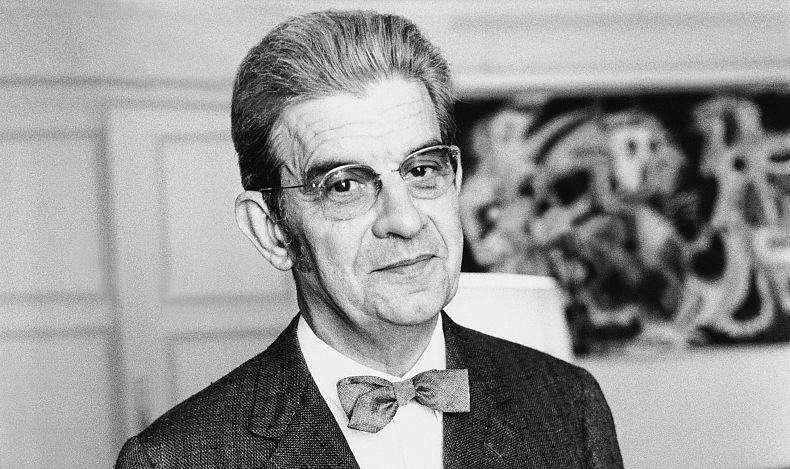In an unpublished seminar interrupted by May 68, Lacan clarified the status of the analyst, who through the 'psychoanalytic act' moves from the position of analysand to that of psychoanalyst.
* Lire en français. The English translation is provided by the editorial staff, who are solely responsible for any inaccuracies.
Jacques Lacan (1901-1981) is currently being honoured at the Centre Pompidou-Metz with an exhibition entitled "Quand l'art rencontre la psychanalyse" ("When Art Meets Psychoanalysis"). His work is also being published by Editions du Seuil with the fifteenth lecture from his Seminar, given in 1967 at the Paris Freudian School.
Entitled "L'acte psychanalytique" ("The Psychoanalytic Act"), this volume contains transcripts of the sixteen public sessions (attended by practitioners as well as students from other specialities and curious listeners) and four seminars closed to the public, intended for psychoanalysts only. The text is edited by Jacques-Alain Miller, and the oral form that persists once the content has been written down makes it accessible to specialists and neophytes alike.
In a way, the theme of this lecture is a continuation of the previous one, entitled "The Logic of Phantasm", but it focuses on a singular problem that Lacan had only hinted at in the past, and which is systematically addressed here: the status of the psychoanalyst himself.
The act in question
As the title of the course emphasises, Lacan's central thesis is that the status of the psychoanalyst is constituted by the "psychoanalytic act". This notion of "act" is not transparent: the author sets out to specify its meaning in the context of psychoanalysis, drawing on classical philosophy from Aristotle to Kant. Within the psychoanalytic tradition, Freud has already given an important place to "missed acts", but we might also think of "acting out".
But Lacan's shift consists in evaluating the notion of the act from the point of view of the psychoanalyst himself. Crucial developments for the redefinition of such an act can be found in lectures 4 and 5. Lacan first explains the meaning of this correlated use of the terms "act" and "psychoanalytic", starting from the paradox that "one of the coordinates" of such an act "is precisely to exclude from the psychoanalytic experience any act, any injunction to act".
But in reality, this expression is not so strange, if we think of it on the model of the "sexual act", the "poetic act" or the "medical act". In all these expressions, the "act" has a performative dimension, something to do with crossing the line, making a decision or committing oneself. The psychoanalytic act is both the crossing over of the analytical experience, when the analysand (a term Lacan substitutes for the analysed) reaches the end of his analysis, and the analysand's commitment to the service of other analysands, when he in turn assumes the status of analyst.
This psychoanalytic act implies a certain transference, which we can conceive of as a conversion of the subject in his relationship to knowledge: it enables him to move from the analysing task to the position of the psychoanalyst. And the subversion of the subject in this sense, according to the very logic of the path of analysis, is the fruit of this act.
Concepts in a polemical context
A reading of this lecture reveals the highly polemical context in which Lacan's developments took place. First of all, within the Freudian School, the year 1967, in which he began his reflections on the psychoanalytic act, coincided with the establishment — at Lacan's own suggestion — of the "pass", which designates the codified procedure by which "the psychoanalyser passes to the psychoanalyst" . There is a great deal at stake in these reflections: Lacan intended to train a new generation of psychoanalysts who would make a relative break with previous practices.
The author also distances himself from certain contemporary trends, such as "psychoanalytic marketing" or, as he develops in session 4 of this course, certain theoretical concepts coming out of the United States.
These critical approaches led Lacan to revisit the study of certain basic psychoanalytical notions — which at the time were being discussed in the field of philosophy — such as 'transference', which is examined here in the light of the notion of intersubjectivity, and the so-called "RSI triangle" (Real, Symbolic, Imaginary), which is removed from a series of simplifications and misinterpretations.
But it is also the political and social context of May 1968 that unexpectedly intervenes in the course of the seminar and precipitates its interruption. In session 15, Lacan announces what is at stake in this historic moment: it is a question of "rising to the occasion". The author reacts to these events, which have a direct impact on the academic world, sometimes with humour: he congratulates de Gaulle on his use of the famous formula "chienlit". At the same time, he respected the students' call for a strike and cancelled some of his seminars — all the while maintaining an impromptu dialogue with his audience.
The irruption of these political events into the psychoanalysis seminar gave rise to some unexpected remarks. For example, Lacan illustrates the concept of the "object a" (the object that causes desire) with the paving stone — torn up and thrown during the student demonstrations: "The paving stone is an object a that responds to another object that is really, then, capital for any future ideology of dialogue when it starts from a certain level: it is what we call the tear-gas can".
From then on, he began to break with close colleagues, some of whom, like Jean-Paul Valabrega, soon left him to found the Fourth Group, while others deserted psychoanalysis to join the Marxist-Leninist movement. In short, this pivotal year in French social history and in the development of Lacan's thinking was an opportunity for the psychoanalyst to clarify and assert his positions.

